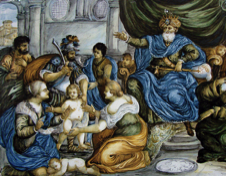The Mindful Docket
King Solomon and Attachment

His judgment is one of most famous in history. He ruled that the baby would be cut in two with each woman receiving half of the baby.
Often this story leaves the listener awed with Solomon’s wisdom, taken with the true mother’s love, and incredulous over the pretender’s heartlessness.
Let’s take a second look with the lens of mindfulness.
First, it bears noting that Solomon’s judgment was to split the baby. We will never know what would have happened were both women to have been satisfied with this decree. After all, these were ancient times. Solomon’s judgment was, at face value, harsh. Rather, it was his WISDOM that rendered the judgment profound. There is much more to say about the difference between wisdom and judgment -- perhaps the very heart of mindfulness practice. But, this is addressed elsewhere.
The two women were clearly attached to the child -- and to the prospect of taking custody. There may well have been thoughts -- judgments of the mind -- along these lines . . . .
This is my baby.
I must have this baby.
If I have this baby, then I will be worthwhile.
I can’t let her take my baby.
My baby will not survive without me.
I love this baby with all my heart.
I’ll do whatever I can to make sure I get my baby.
Jurisight reminds us that many of these thoughts and beliefs may constitute “Hearsay” and that a “Due Diligence” inquiry could be helpful in clarifying the mind and intentions.
But left uninvestigated, these beliefs can take hold of the mind and form a powerful attachment that becomes an obsession, leading one into a state of mind that is reactionary and intent on one thing and one thing only -- satisfying the judgment (i.e., “I can’t let her take my baby.”)
While both women were attached to the idea of gaining custody, we can tell that their individual beliefs were different along with the intensity of the attachments.
In the end, one woman was so attached to her judgment, her determination to get the baby, that she would have agreed to custody of half of a dead infant. While she may have been condemned for this conduct, it can be worthwhile asking ourselves whether there have been occasions when we have been so attached to a need that we reacted without compassion or perspective.
And, as for the woman who received custody -- by her willingness to let go, we might consider how LOVE for the child factored into her conduct. Was LOVE her only expression? Or, like most of us, was she motivated by both a genuine state of love, and also by a series of attachments as reactive as the other women’s?
In the end, we appreciate that she drew upon a deep founded sense of love -- perhaps a mother’s love -- and that this present state of mind and body was the source of wisdom and compassion that led her to let go of her attachments. Doing so, she embraced the heart of freedom, and her child.